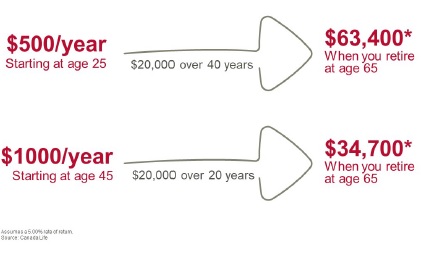Looking at retirement
Start planning your retirement today
| Early career | Have a savings plan and start putting money aside for retirement. The earlier you begin to save, the more financially secure you will be in retirement. The graphic below illustrates how starting to save for retirement earlier results in higher savings than starting later, even if you contribute the same amount. The top of the graphic shows that contributing $500 per year to savings starting at age 25 would equal contributions of $20,000 over 40 years, and assuming a 5% rate of return, you would have $63,400 when you retire at age 65. Below, it explains that contributing $1000 per year starting at age 45 would also equal contributions of $20,000 over 20 years. This strategy results in less savings, only $34,700 saved for retirement at age 65, assuming a 5% rate of return. |
||||||||
| Mid-career | Start planning what you want to do during your retirement – will you pursue a hobby, travel, volunteer or work part-time. This will help you with your planning. Example: Paul is in mid-career and he wants to pursue his hobby of woodworking when he retires. His daughter has just bought a house and he plans to help her with some renovations. Paul’s desired monthly retirement income in today’s dollars is $3,500 per month, approximately 70 per cent of what he currently earns. Paul expects to receive the following retirement income. Yearly gross income before retirement Planned retirement income (70% of current income)
Paul will need to save approximately $13,000* in today’s dollars to receive $70* per month starting at age 65. *These numbers are used for illustration purposes only and are based on the maximum benefits for 2021 for the CPP and OAS. |
||||||||
| Late-career | Fine tune your financial preparations so you can achieve your lifestyle plan. Begin to enjoy the activities you have planned for a smooth transition to retirement. |
Financial and retirement planning facts
Recent reports suggest that nearly a third of young Canadians have not saved any money for retirement, even though many say they want to leave the workforce before age 60. The reality is that Canadians are living longer and spending more time in retirement.
Your retirement income can come from three sources
| Employer |
|
| Government |
|
| Personal |
|
5 steps to build your retirement
| Step 1 | Familiarize yourself with your DC pension, the Canada Life member website and all the resources available to you. |
| Step 2 | Set realistic goals. Refer to tools like the Canada Life Retirement Goals tool. The tool helps you determine how much you need to save now to provide you with your desired income level at retirement. To access this tool, visit mycanadalifeatwork.com. There are also helpful tools and resources on Smart Path at smartpathnow.com. |
| Step 3 | Develop your plan. For help, refer to the my Investments guide and the Investment personality questionnaire. You may also wish to discuss your investment options with a personal financial advisor. You are responsible for any costs associated with seeking such advice. If you don’t have a financial advisor, the Employee Assistance Program (EAP) can help you. You can also connect one-on-one with a member guide, a non-commissioned, licensed professional who’s dedicated to delivering personalized support for your health and wealth plans. Click here to book a meeting. |
| Step 4 | Contribute and save as early you can. Maximize your contributions to ensure that you take advantage of Canada Post’s matching contributions. Consider complementing your pension savings with the Voluntary Savings Plan (VSP). |
| Step 5 | Review your investment choices regularly. |

